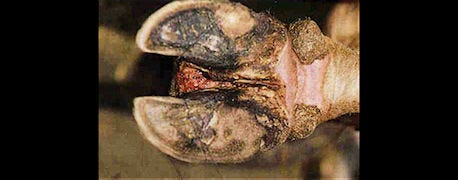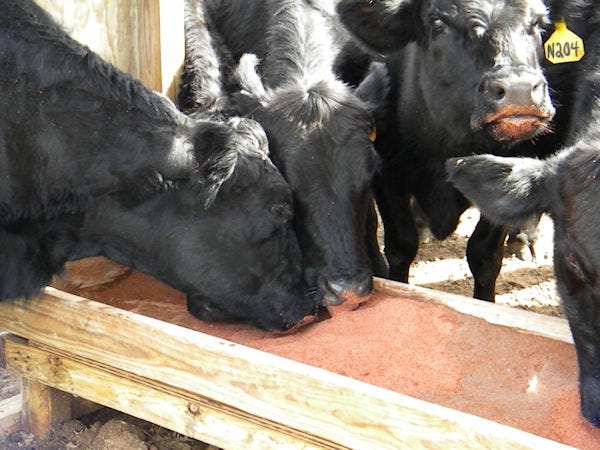February 11, 2016

Sponsored Content
The incessant rains in some areas of the country that we’ve had these past months have created a problem that we haven’t seen in recent years – standing water. Sometimes, despite our best efforts, cattle have to stand in this water resulting in more cases of foot rot. Why should you care you ask? Lame cows won’t eat enough and thus won’t make enough milk for calves and lame calves won’t graze either, resulting in further reduced weight gains. Lame bulls will not travel to seek out females in heat, meaning more open cows at the end of breeding season.
Why Does Wet Weather Cause More Foot Rot?
 Lameness caused by foot rot will result in poor productivity and lost profits.
Lameness caused by foot rot will result in poor productivity and lost profits.
Foot rot is caused by anaerobic bacteria that cannot penetrate intact healthy hoof tissue. However, when cattle continually stand in water and mud, their hooves soften, just like your fingernails after a long bath. Softened hooves are less impervious to punctures and abrasions, thus giving the foot rot bacterium a route into the hoof. Therefore, we see more foot rot in herds exposed to long periods of wet weather.
Signs of Foot Rot
Foot rot is first characterized by swelling between the toes. Eventually the skin splits open to reveal necrotic, foul-smelling tissue. The affected foot will be warm to the touch. Cattle often run a temperature and appear lethargic. The initial reddening of the skin is sometimes known as foot scald. If left untreated, the infection may progress up the foot into the joints, tendons and bone. If this occurs, the animal rarely recovers.
 Proper supplementation of zinc and copper can help reduce the incidences of foot rot on your farm.
Proper supplementation of zinc and copper can help reduce the incidences of foot rot on your farm.
Other conditions causing lameness are often misdiagnosed as foot rot. These include: sole ulcers and abscesses, sole abrasions, cuts, punctures and laminitis. Cattle grazing endophyte-infected fescue pastures that have developed fescue toxicity experience a loss of blood circulation to the feet causing lameness, and are sometimes misdiagnosed as having foot rot. For these reasons, it is important to examine the affected animal(s) closely to confirm that the problem is in fact foot rot.
Transmission
Contagious foot rot is mainly spread by infected animals. The bacterium travels from the infected animal to the soil to non-infected animals. These bacteria can survive in the soil from 1 to 10 months and even longer within the hoof tissues. Problems are usually introduced into a “clean” herd by purchase of an infected animal, mixing “clean” animals with infected animals or by using a facility (such as sale barn) after infected animals. Humans can also spread the disease on their boots or vehicles.
Prevention
Do not purchase animals from herds that show signs of lameness. Always quarantine new animals (from any source) before introducing them into your herd. If you observe signs of lameness, clean and examine the foot to establish that you are dealing with foot rot. In mild cases topical application of zinc sulfate solutions or other acceptable treatments may be all that is necessary. In severe cases antibiotics may be in order. Consult your local veterinarian for more information about diagnosis and treatment. Cattle that display chronic foot rot symptoms should be culled, as they will act as a reservoir for the foot rot organisms for the entire herd.
Management practices that help reduce hoof damage can help to reduce the incidence of foot rot in your herd. Maintain good drainage in and around watering and feeding areas. You may also think about placing concrete pads in these areas to reduce the amount of mud. Do not utilize sharp gravel in travel lanes. Proper mineral nutrition, especially zinc and copper, can also help to improve hoof integrity and strength and reduce the incidences of foot rot.
Role of Zinc and Copper in Hoof Integrity
Zinc is a critical nutrient involved maintaining hoof tissues, including, but not limited to, stimulating growth, production of keratin (the part that makes the hoof hard), improved wound healing and improved cellular integrity. Zinc-deficient cattle exhibit increased claw and hoof disorders as well as skin disorders and poor wound healing. Improved zinc nutrition has been proven to improve hoof health in deficient animals.
Copper is required for healthy claw horn tissue as well as antioxidant activity. Copper deficiency decreases the structural strength of hoof tissue. Copper deficiency also results in decreased immunity, infertility and decreased growth.
Supplementation
Natural deficiencies in soils as well as high levels of antagonists make proper supplementation of zinc and copper extremely important for all cattle. Cattle producers who have observed lameness in their cattle should consider using a mineral supplement with enhanced levels of copper, as well as balanced levels of zinc and other essential minerals and vitamins.
In summary, foot rot increases during prolonged wet weather. There are many management practices that you can employ to reduce the incidences of foot rot on your farm. Included among these is proper supplementation of zinc and copper. Many cattle show deficiency symptoms including: discolored hair coats, slow to shed out of winter coats, depressed immunity, decreased conception rates, increased days open, and hoof problems.
If your cattle experience any of these symptoms, consider using one of the SWEETLIX® CopperHead® line of mineral supplements to help enhance copper and zinc nutrition. Visit www.sweetlix.com to find out which SWEETLIX® Livestock Supplement will best suit your needs.
You May Also Like




